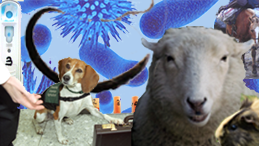
ANSC20003 Topics in Animal Health
Prac 1: Mastitis Diagnostics
Prac 1: Mastitis Diagnostics


Introduction
A dairy farmer has had several cases of mastitis in her 280-cow herd over the past few months. Her milk factory has sent reports indicating a rise in the Bulk Milk Cell Count (BMCC) to 560,000 cells/ml. The farmer has sent samples taken from the herd. Now these have arrived at the diagnostic lab what information can be given to the farmer? What should she do?The farmers dairy herd
Dairy cattle are susceptible to a disease complex called mastitis. This complex comes in many forms. In acute or clinical mastitis there are obvious signs that an infection is active in the mammary gland: swelling, soreness, heat and clots in the milk. Signs such as these will generally be obvious to the farmer and elicit appropriate treatment.
More insidious is ‘sub-clinical’ mastitis. This is caused by a bacteria gaining access to the milk in the mammary gland and causing an infection. But the signs of the infection are far more subtle. The farmer may be unaware of the infection and therefore the cow remains untreated. Eventually this can lead to long-term damage to the structure of the mammary gland and loss of function and therefore milk production. This disease has become a major limitation on production and a common threat to the long-term health of the cows. Obviously it is preferable to prevent the infection.
The farmer may be alerted to the fact that sub-clinical mastitis is occurring by the presence of high numbers of white blood cells and inflammatory cells in the milk MCC (Milk Cell Count). This may then lead to sampling the milk from a number of the cows. The samples are then sent off to the laboratory to see if bacteria grow, and if so, their relative numbers and the type. The type of bacteria grown can indicate how the infection is occurring. The bacteria causing sub-clinical mastitis are broadly divided into two types:
- Contagious organisms – these are spread from cow to cow. Reservoir of infection is the udder of infected cows; spreads from cow to cow, primarily during milking.
- Environmental organisms – these are contracted through contamination from the soil and skin. Reservoir of infection is the environment of the cow - laneways, stalls, etc. Organisms gain entrance through a fatigued teat canal after milking or during milking. Wet milking platforms or wet environment are often involved.
Cows lying on a wet milking yard
There are many thousands of different species of bacteria (ignoring sub-species and strains!) and so the task may initially seem daunting, but the key is to have an idea of what you are looking for or may find.
In this case we are following the procedures to identify bacteria that may be found in milk samples and may cause mastitis. The list of bacteria likely to be found under these circumstances is still quite long but limited. Many bacteria, for example, will not multiply in the presence of oxygen (anaerobes). We are unlikely to find these bacteria in a milk sample and so we will not use the techniques required to grow them.
With this list of possible bacteria, the laboratory needs to a strategy to detect them. Such a strategy is indicated by the key attached. Although there are an enormous number of possible media to grow bacteria and tests to perform on them, the strategy must merely be able to separate the members of the list. As well sufficient information may be provided by only identifying the species type rather than the specific species (and sub-species and or strain). This simplifies the task considerably.